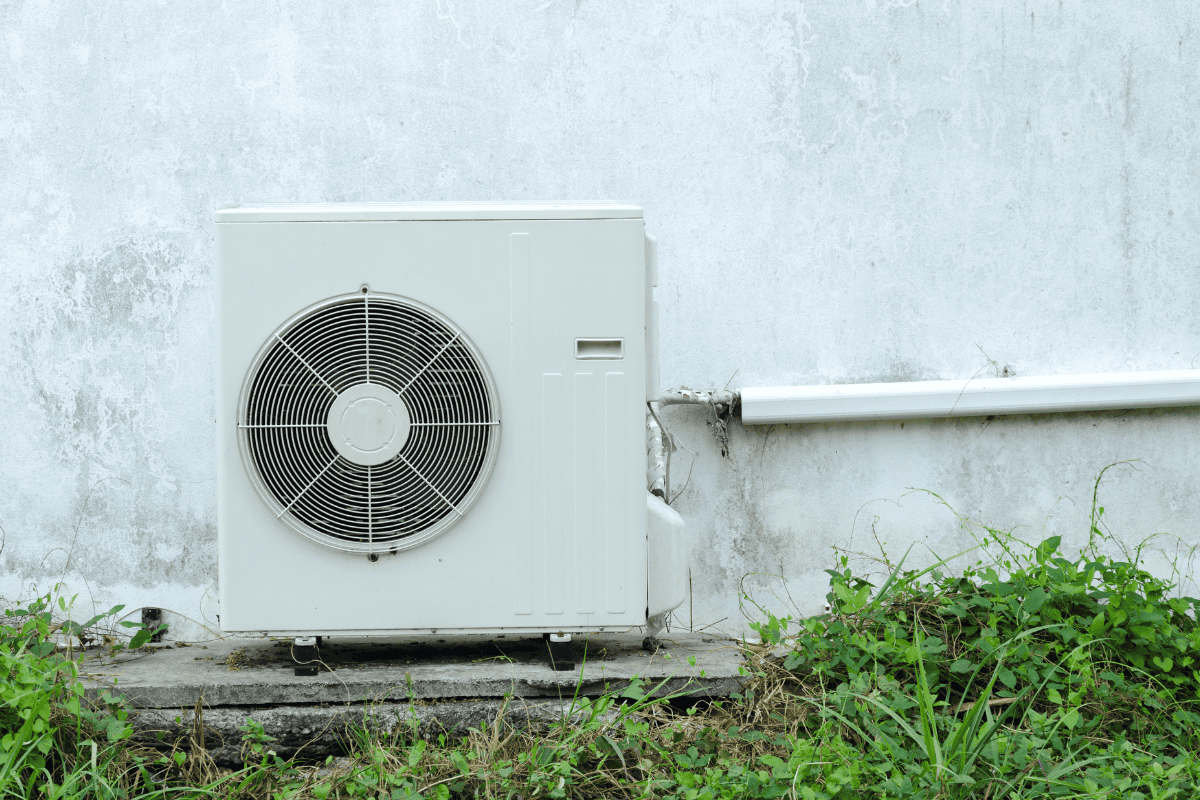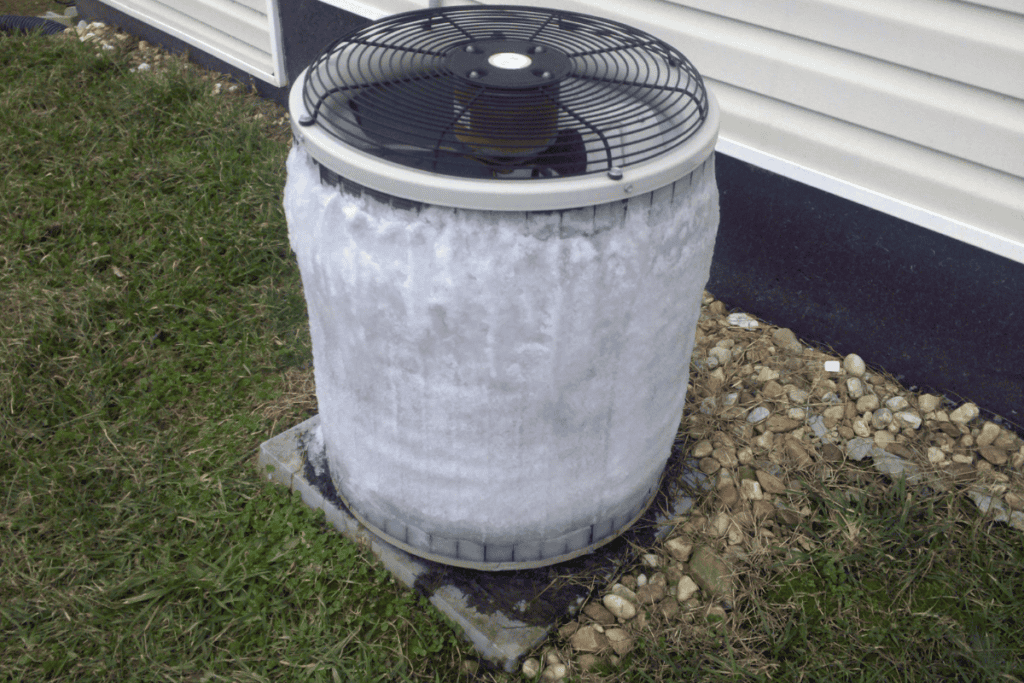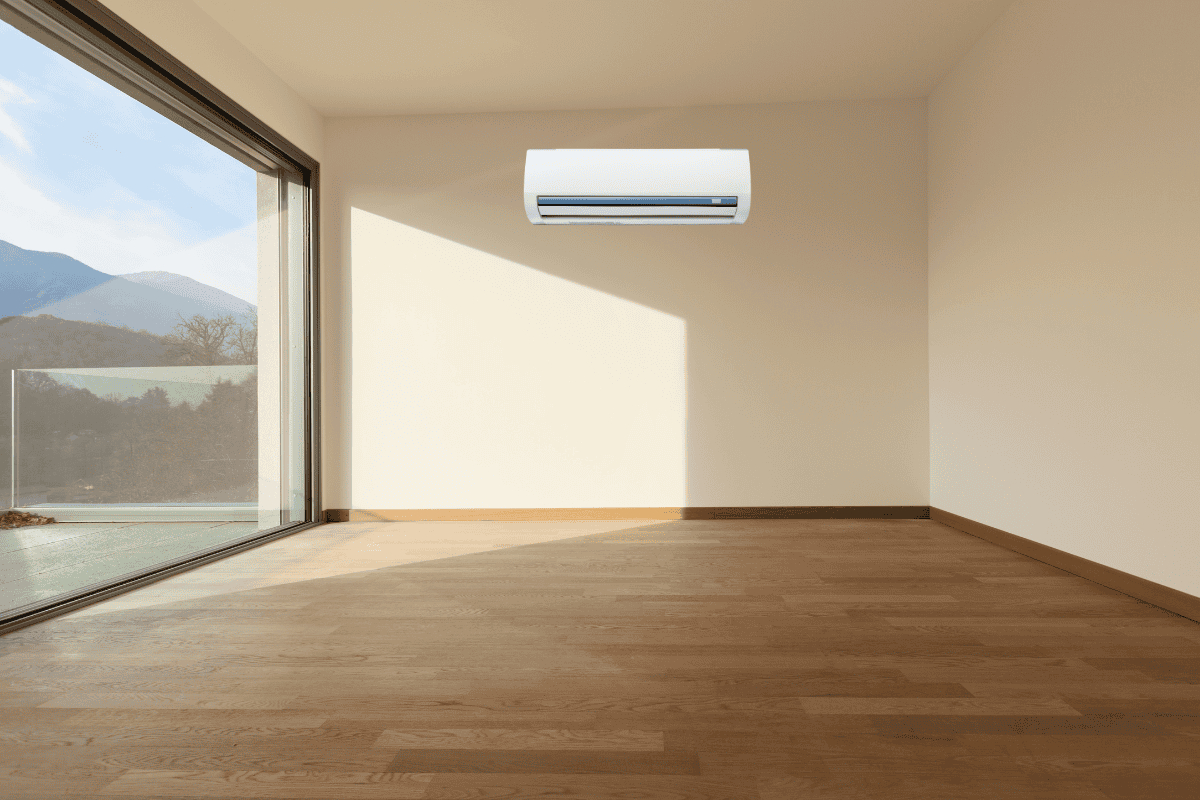13 Reasons Why Air Conditioner is Not Blowing Cold Air [Includes Solutions]

Imagine: It’s a really hot day, and you’re looking forward to relaxing in your cool house. But when you turn on your air conditioner, it isn’t blowing cool breeze. Annoying, right? This problem is more common than you might think, and it’s important for everyone to know about it.
Our homes should be comfortable places to be, and a working AC is a big part of that. But a conditioner that’s not blowing cold air can make your home feel stuffy and cause your energy costs to go up. So, how do you deal with this?
We are here to help you to get your unit running again on these hot and humid days.
In this guide, we’re going to explain the 13 most common reasons your ac not blowing cold air and show you how to fix them. We aim to give you helpful tips and easy steps to follow to get you comfortable again.
Contents
- 1 Reasons Your Air Conditioner Is Not Blowing Cold Air
- 2 1. Power Issues
- 3 2. Leaking or Low Refrigerant In Your AC Unit
- 4 3. Dirty or Clogged Air Filter
- 5 4. Issue with Evaporator Coil or Condenser
- 6 5. AC Unit’s Clogged Drain
- 7 6. Dirty Air Compressor
- 8 7. Blocked Registers
- 9 8. Issue with Thermostat Set Of The Air Conditioner
- 10 9. Ice Buildup in AC
- 11 10. Leak in Air Ducts of AC Unit
- 12 11. Condensate Airflow Switch
- 13 12. Undersized Air Conditioner
- 14 13. Incorrect Thermostat Placement
- 15 When to Contact HVAC Angel?
Reasons Your Air Conditioner Is Not Blowing Cold Air
There are several reasons your ac may not be cooling but there’s no need to panic in this humid weather. You can deal with most of these issues by yourself. Our comprehensive guide addresses all these issues in depth and gives you step-by-step solution.
1. Power Issues
One of the most common reasons for an air conditioner that’s not blowing cool air is a lack of power. If your unit is not receiving adequate electrical power, it won’t be able to function properly and cool your home. This issue can be caused by a tripped circuit breaker, a blown fuse, or a malfunctioning thermostat.
Solution
- Check your circuit breaker box to see if the breaker for your unit has tripped. If it has, simply flip it back to the “on” position. If the breaker trips again, there may be an underlying electrical issue that requires professional assistance.
- Inspect your thermostat to make sure it’s set to “cool” and the desired temperature is lower than the current room temperature.
- If there was a recent power surge, it might have affected your AC unit. Power surges can damage electrical components within the unit, potentially requiring professional repairs.
2. Leaking or Low Refrigerant In Your AC Unit
Refrigerant is the substance that allows your cooling unit to cool your home effectively. If your AC system has a refrigerant leak or the refrigerant levels are low, it will struggle to make your home cooler. Some common signs of a refrigerant leak include:
- Hissing or bubbling sounds coming from the unit, a potential sign that your air conditioner is not blowing cold air as it should.
- Frozen evaporator coils.
- Increased humidity levels in your home.
- Longer Cooling Cycles
- Higher Electric Bills due to inefficient air flow
Solution
If you suspect a refrigerant leak or low refrigerant levels, it’s better to contact a licensed HVAC professional as soon as possible. Attempting to handle refrigerant issues on your own can be dangerous and may cause further damage to your unit
Regular maintenance of your system can help prevent refrigerant leaks and keep your AC unit functioning properly. During routine check-ups, our technicians can identify issues and address them before they lead to more serious problems.
3. Dirty or Clogged Air Filter

A dirty or clogged filter is another common reason for your unit not cooling. The filter’s purpose is to trap dust, dirt, and other particles, preventing them from entering your AC system and causing damage.
When the filter becomes excessively dirty, it restricts airflow, making it difficult for your unit to work effectively.
Using the wrong type of filter can also contribute to this issue.
It’s important to choose the right kind of filter for your home that can perform optimally and prevent your unit from struggling to provide you comfort.
Solution
- To resolve this issue, start by checking your conditioner’s filter and replacing it if it appears dirty or choked. Most manufacturers recommend replacing your filter every 1-3 months, depending on usage and environmental factors.
- When selecting a new filter, make sure to choose one that is compatible with your unit and meets your home’s specific needs.
- Keep in mind factors such as filter size, MERV rating, and material to make sure you’re using the most appropriate filter for your system.
- If you’re unsure about which type of filter to use, consult your AC unit’s owner’s manual or seek guidance from HVAC professionals like us. We can help you determine the best filter option for your home, taking into account factors such as allergies, pets, and overall indoor air quality.
- Regular maintenance, including cleaning or replacing your filter, can help prevent this issue from occurring and helps your unit to continue to do its work efficiently.
- As a rule of thumb, you should clean or replace your filter every month or two during seasons of peak use, according to the U.S. Department of Energy.
4. Issue with Evaporator Coil or Condenser
The evaporator coil and condenser are the main components of your air conditioning system, responsible for keeping your home cool. If either of these components is dirty, damaged, or malfunctioning, it can be the reason your ac is not cooling.
The coil, located in the indoor unit of your AC system, absorbs heat from the atmosphere inside your home. If it is dirty or covered in ice, it can’t effectively remove heat from the air. So, what happens is that your unit is blowing air but it’s warm.
Similarly, if the condenser, which is part of the outdoor unit, is dirty or damaged, it can’t release the heat absorbed from your home’s atmosphere, compromising the cooling process.
Solution
To address these issues, follow these steps:
1. Clean the evaporator coil: Turn off your unit and gently clean the coil using a soft brush or a coil cleaning solution. Be careful not to bend or damage the delicate fins on the coil.
2. Clean the condenser: Remove any debris, such as leaves or grass clippings, from around the outdoor unit. Use a hose to gently spray the condenser coils and remove dirt and grime. The condenser should have proper airflow and should not be obstructed by vegetation or other objects.
3. Check for ice buildup: If you notice ice on the coil, turn off your AC and allow the ice to melt. This may indicate a more serious problem, such as a refrigerant discharge, which requires professional attention.
5. AC Unit’s Clogged Drain
A clogged drain line is another reason your ac is not blowing cold air. As your unit cools your home, it also removes moisture from the atmosphere which condenses and flows through the drain line. If this line becomes jammed with dirt, algae, or debris, it can cause water to back up into the system, leading to various problems.
Solution
To unclog your AC drain line and restore proper cooling, follow these steps:
1. Collect supplies: Gather a wet/dry vacuum, distilled white vinegar, bleach, and a funnel.
2. Turn off the AC’s power: Shut off your air conditioner and the circuit breaker.
3. Remove the drain line cap: Locate the drain line near your indoor unit and remove the cap.
4. Look for the clog: Check for any visible clogs or debris near the opening of the drain line.
5. Loosen debris in the line: Use a wet/dry vacuum to remove any accessible debris from the drain line.
6. Pour in diluted vinegar or bleach solution: Mix equal parts water and distilled white vinegar or a small amount of bleach with water. Slowly pour this solution into the drain line using a funnel.
7. Flush the pipe: Allow the solution to sit in the drain line for about 30 minutes, then flush the pipe with hot water to remove the remaining debris.
8. Monitor the system’s performance: Replace the drain line cap and turn your unit back on. Check for any signs of water leakage.
6. Dirty Air Compressor

The air compressor is the heart of your air conditioning system, responsible for compressing refrigerant and circulating it through the coils to cool your home.
When the compressor becomes dirty or covered in debris, it can’t function efficiently, leading to reduced cooling capacity and warm air blowing from your vents.
A dirty compressor can also cause your unit to work harder, consuming more energy and leading to premature wear and tear on other components. Besides this, a poorly functioning air conditioner may not effectively remove humidity from the air, creating an environment conducive to mold and mildew growth.
According to Centers for Disease Control and Prevention, these allergens can trigger respiratory problems and allergies, posing potential health risks.
Solution
To address a dirty air compressor and restore your unit’s cooling performance, follow these steps:
1. Turn off the power: Shut off your unit at the thermostat and the circuit breaker.
2. Clean the outdoor unit: Remove any debris, such as leaves, twigs, or grass clippings, from around the outdoor compressor unit. Use a hose to gently spray the exterior of the unit, removing dirt and grime from the compressor and condenser coils.
3. Straighten bent fins: If you notice any bent fins on the condenser coils, use a fin comb to gently straighten them, to maintain proper airflow through the unit.
4. Check for obstructions: Make sure there are no objects or vegetation blocking the airflow around the outdoor unit. Maintain a clearance of at least 2-3 feet on all sides of the compressor.
7. Blocked Registers
Registers, also known as air vents or grilles, are the openings in your walls, floors, or ceilings that allow conditioned air from your system to enter each room. When these registers are blocked, closed, or obstructed, they can restrict airflow and prevent your unit from effectively cooling your home.
If you notice that your unit is running but not blowing cold air, or if some rooms feel warmer than others, blocked registers may be the culprit.
When a register is completely closed or obstructed by furniture, curtains, or other objects, it can significantly reduce the amount of cool air entering the room.
In some cases, a blockage in the ductwork itself may be restricting airflow to certain areas of your home.
Solution
To maintain proper airflow and efficient cooling, follow these steps to address blocked registers:
1. Check all registers: Walk through your home and inspect each register. Make sure furniture, curtains, or other items are not blocking the airflow from the vents.
2. Adjust register dampers: If your registers have adjustable dampers, make sure they are set to the open position to allow maximum airflow into the room.
3. Clean the registers: Remove the register covers and use a vacuum or duster to clean any dust, dirt, or debris that may be restricting airflow. Be sure to clean both the front and back of the register.
4. Check for ductwork blockages: If a particular room remains warm despite having open and clean registers, there may be a blockage in the ductwork.
8. Issue with Thermostat Set Of The Air Conditioner
A malfunctioning or improperly configured thermostat can cause your air conditioner to stop emitting cold air. The thermostat is responsible for controlling your AC system, sensing the room temperature, and signaling the unit to cool the space when needed.
If it is not working correctly, it may send the wrong signals to your unit, causing it to emit warm air or not turn on at all.
Solution
- Check the settings
- Thermostat should be set to “Cool” mode and that the temperature is set lower than the current room temperature.
- If it has a fan setting, make sure it is set to “Auto” rather than “On” to avoid continuous releasing of air.
2. Replace the batteries
- If your thermostat operates on batteries, replace them with fresh ones for proper operation.
3. Clean the thermostat
- Carefully remove the cover and gently clean any dust or debris from the interior components using a soft brush or compressed air. This can fix issues where the ac unit’s thermostat isn’t accurately gauging the temperature.
4. Check for loose wiring
- If you are comfortable with electrical work, turn off the power to your system and remove the thermostat cover to check for any loose or damaged wires.
9. Ice Buildup in AC

Ice buildup on your air conditioner’s evaporator coil can prevent your system from releasing cold air effectively. it is responsible for absorbing heat from the air inside your home, and when it becomes covered in ice, it can’t perform this function efficiently.
One common cause of ice buildup is low refrigerant levels. When your AC system is low on refrigerant, the pressure drops, causing the coil to become abnormally cold.
As a result, when the hot air from your home passes over the extremely cold coil, moisture from the air condenses and quickly freezes on the coil’s surface.
If left unchecked, this process continues until the entire coil is encased in ice, restricting airflow and preventing your air conditioner from blowing cold air.
Solution
To address ice buildup and restore proper cooling, follow these steps:
1. Turn off your AC: Shut off your air conditioner at the thermostat and the circuit breaker to allow the ice to melt naturally. Do not attempt to remove the ice manually, as this can damage the delicate coil fins.
2. Check the air filter: A dirty or clogged air filter can restrict airflow over the evaporator coil, contributing to ice buildup. Replace your filter if it appears dirty or hasn’t been changed in the last 1-3 months.
3. Inspect the coil: Once the ice has melted, visually inspect the evaporator coil for any signs of damage or excessive dirt and debris. If the coil appears dirty, gently clean it with a soft brush.
4. Check for refrigerant leaks: Low refrigerant levels, often a cause of your ac not cooling, are usually caused by leaks in the system. If you suspect a refrigerant leak, contact our HVAC technicians to locate and repair the leak, then recharge your system with the proper amount of refrigerant.
5. Monitor the system: After addressing the underlying issues, turn your unit system back on and monitor its performance.
10. Leak in Air Ducts of AC Unit
Leaks in your air conditioner’s ductwork can cause a substantial loss of cold air, leading to reduced efficiency. Ductwork leaks can occur due to various reasons, such as improper installation, damage from pests or debris, or general wear and tear over time.
When conditioned air escapes through these leaks, your system has to work harder to maintain the desired temperature, which can result in the unit giving out warm air or struggling to keep your home cool.
Solution
1. Inspect the ductwork visually
- Look for any obvious signs of damage, such as holes, tears, or disconnected sections.
2. Check for proper insulation
- Check that to your ductwork is properly insulated, especially in unconditioned spaces like attics or crawlspaces.
3. Seal visible leaks
- If you discover any visible leaks or gaps in your ductwork, seal them using mastic sealant or metal tape specifically designed for HVAC systems.
11. Condensate Airflow Switch
A faulty condensate airflow switch can cause your air conditioner to stop blowing cold air. When the switch detects a blockage in the drain line or an overflow in the drain pan, it shuts off the system to prevent further water accumulation.
A malfunctioning switch can falsely detect an issue and shut down your air conditioner even when there’s no actual problem with the condensate drainage.
Solution
1. Inspect the switch
- Check for any visible damage or debris that may be causing the switch to malfunction.
2. Test the switch’s continuity
- If the switch appears clean and undamaged, use a multimeter to test its continuity.
- If the switch fails the continuity test or appears damaged, it needs to be replaced.
- Remove the old switch and install a new one, make sure that it is securely connected and properly positioned.
12. Undersized Air Conditioner

An undersized air conditioner can be one of the reasons your unit might not be cooling your home effectively. If your unit is too small for the space it needs to keep cold, it will struggle to maintain a comfortable temperature, leading to several issues, including:
1. High Energy Bills: A wrong-sized air conditioner will run continuously to try and keep up with cooling demands, consuming more energy and resulting in higher utility bills. On extremely hot days, the unit may even overheat and shut down completely due to the motor overheating or the evaporator coils freezing.
2. Lack of Comfort: Despite setting your thermostat to a comfortable temperature, an undersized AC may never reach the desired level, leaving you feeling warm and uncomfortable in your home. The unit will struggle to remove heat and humidity effectively, resulting in an unpleasant indoor environment.
Solution
To address the issue of an undersized air conditioner, consider the following options:
1. Upgrade to a properly sized unit: The best long-term solution is to replace your undersized air conditioner with a unit that is appropriately sized for your home. Work with an HVAC professional to perform a load calculation, which takes into account factors such as your home’s square footage, insulation, window sizes, and local climate to determine the correct AC size.
2. Improve insulation and seal air leaks: While not a complete solution, improving your home’s insulation and sealing air leaks can help reduce the workload on your undersized AC. This will make it easier for the unit to maintain a comfortable temperature and may help prolong its lifespan.
3. Use supplemental cooling methods: In the short term, you can use fans, window units, or portable air conditioners to provide additional comfort in specific areas of your home. This can help alleviate some of the strain on your undersized central air conditioner.
13. Incorrect Thermostat Placement
If your thermostat is installed in a location that doesn’t accurately represent the temperature of your living space, such as near a window or in direct sunlight, it may cause your air conditioner to behave erratically or fail to give out cold air consistently.
Solution
Your thermostat should be placed away from heat sources, direct sunlight, and drafts. Ideally, it should be installed on an interior wall in a central location of your home.
If necessary, you can also relocate it to a more suitable position to ensure accurate temperature readings and optimal air conditioner performance.
When to Contact HVAC Angel?
At HVAC Angel, we understand that a malfunctioning air conditioner can be a source of frustration and discomfort, especially during the hot summer months. If you’ve tried the solutions mentioned in this article and your AC still doesn’t blow cold air, or if the issue keeps recurring, it’s time to contact our team of experienced HVAC technicians to get your air conditioning repaired.
Our professionals have the experience and equipment necessary to diagnose and resolve even the most complex HVAC problems and get your air conditioner running again.
Whether you’re dealing with a refrigerant leak, a faulty compressor, or an undersized AC unit, our technicians can provide the guidance and support you need to restore your system’s performance and make your home comfortable again.
Don’t let a malfunctioning air conditioner disrupt your daily life or compromise your indoor air quality. If you’re experiencing persistent issues with your AC system, contact our ac technicians at HVAC Angel today. Our team is ready to help you identify the root cause of the problem and implement a effective solution tailored to your specific needs.
With HVAC Angel’s commitment to quality service and customer satisfaction, you can trust that your air conditioning system is in capable hands. Let us help you beat the heat and enjoy a comfortable home all summer long.
Frequently Asked Questions (FAQs)
1. Why is my ac not blowing cold air?
If your AC unit is blowing warm air instead of cold air, it could be due to several reasons such as a refrigerant discharge, a dirty air filter, or a problem with the compressor. It’s recommended to consult a professional AC repair service to diagnose and fix the issue.
2. How can I improve the efficiency of my air conditioning system?
To better the performance of your air conditioning system, you should regularly clean or replace the filter, maintain proper ventilation and airflow within your home, and schedule routine maintenance of your heating and air conditioning system for your HVAC system. Optimizing your thermostat settings can also contribute to greater energy efficiency.
3. What should I do if my AC unit is not working properly?
If your unit is not functioning as expected and not making your home cold enough, you can check for common issues such as a faulty thermostat, a trip in the circuit breaker, or a clogged evaporator coil, a common reason why an AC stopped blowing cold air.. In case of persistent problems, it’s advisable to seek professional assistance for your heating and cooling problems.
4. How often should I change the air filter in my central air system?
For optimal performance, it’s recommended to change the air filter in your central air system every 3 to 6 months, depending on factors such as usage and air quality in order to enjoy clean air. A clogged filter can be the reason, air may not be passing out freely and may lead to hot air being circulated in the house.
